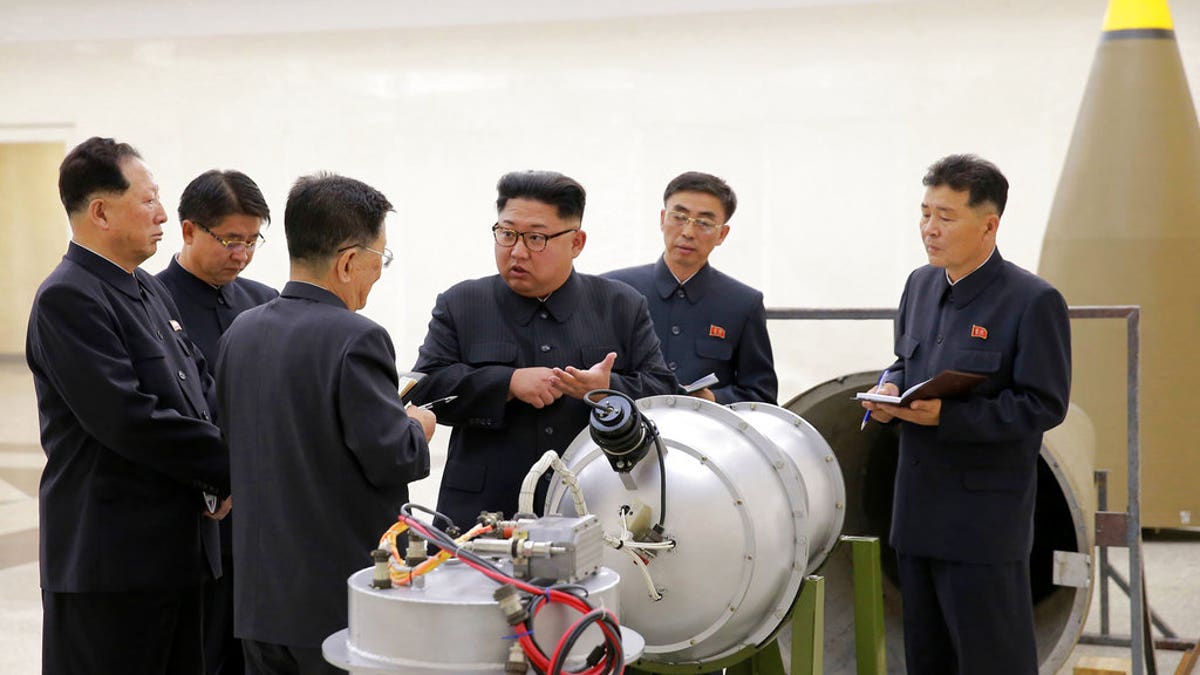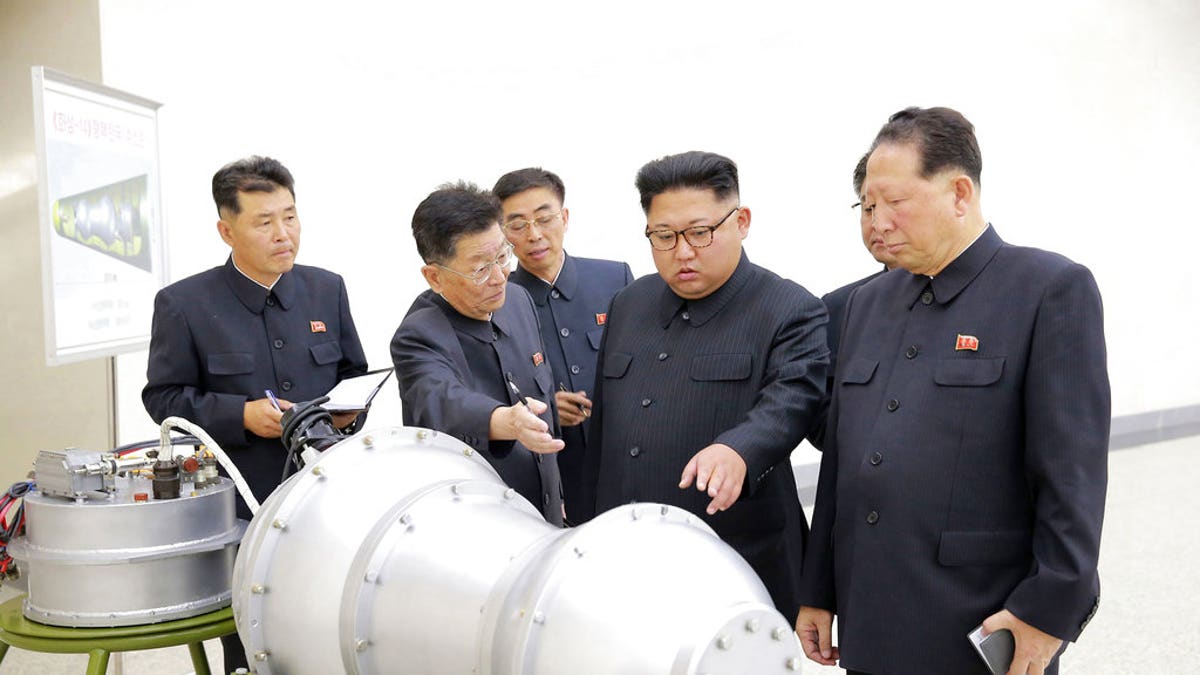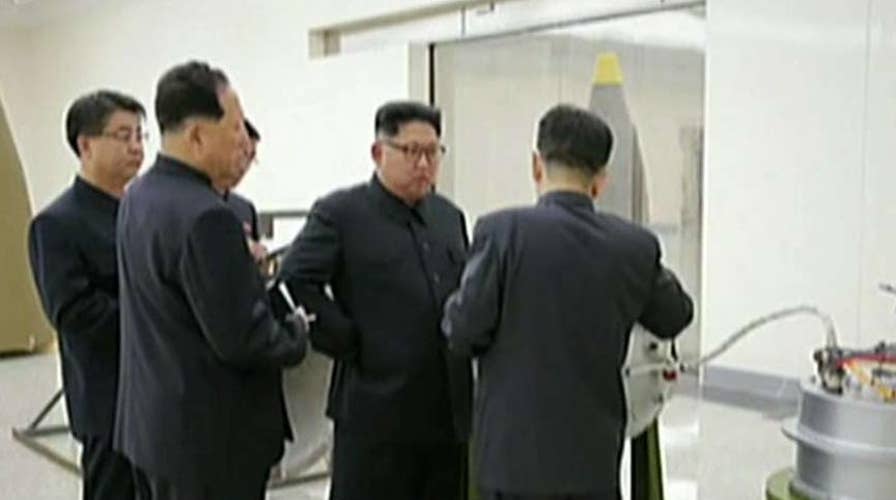North Korea said on Sunday it detonated a hydrogen bomb, possibly triggering an artificial earthquake and prompting immediate condemnation from its neighbors -- despite the rogue regime calling the test a "perfect success."
The blast, carried out at 12:29 p.m. local time at the Punggye-ri site, triggered a magnitude 6.3 earthquake in North Korea that was detected 55 kilometers north northwest of Kimchaek, U.S. Geological Survey reported. Officials in Seoul initially said it was a magnitude 5.7 quake.
Just hours before Sunday's test, photos emerged in a newspaper showing dictator Kim Jong Un inspecting what it said is a new thermonuclear warhead in a lab. This would be North Korea's sixth nuclear test and first since September 2016.
David Albright, President of the Washington-based Institute for Science and International Security, one of the leading global experts on North Korea, told Fox News the new test is "alarming."
"This is a crisis…this size of this device is a city-buster…the yield of this blast is significant…it could cause significant damage," Albright said. "It is alarming."
Albright previously said North Korea has made it a priority to develop thermonuclear weapons. He said on Sunday the recent rest could have been a crude thermo-nuclear device.

North Korea released photos of Kim Jong Un on Sunday showing him inspecting the loading of a possible hydrogen bomb into a new intercontinental ballistic missile. (AP)
"And that’s a bad thing," Albright said, adding that the rogue nation has moved faster than he expected.
The test was estimated to have a yield of 100 kilotons, meaning a blast that was four to five times more powerful than the explosion in Nagasaki, Japan, in 1945, a South Korean defense official told the country's Yonhap News Agency. Albright said it will still be a challenge for North Korea to develop an ICBM that could hold a hydrogen bomb.
"But they know how to scare us," Albright said.
President Trump condemned the test on Twitter Sunday morning, calling the rogue nation's actions "very hostile and dangerous."
"North Korea has conducted a major Nuclear Test. Their words and actions continue to be very hostile and dangerous to the United States," Trump tweeted.
"North Korea is a rogue nation which has become a great threat and embarrassment to China, which is trying to help but with little success," he added. "South Korea is finding, as I have told them, that their talk of appeasement with North Korea will not work, they only understand one thing!"
White House Press Secretary Sarah Sanders released a statement saying the National security team was "closely" monitoring the situation.
"The President and his national security team will have a meeting to discuss further later [Sunday]. We will provide updates as necessary," Sanders said.
Japan and South Korea immediately condemned the nuclear test. South Korea's presidential office said U.S. National Security Adviser H.R. McMaster spoke with his South Korean counterpart, Chung Eui-yong, for 20 minutes in an emergency phone call about an hour after the detonation.
Japan's Prime Minister Shinzo Abe called the test "absolutely unacceptable."
The U.S. Air Force's WC-135 "sniffer" planes in Japan will be measuring the air samples near the Korean Peninsula to confirm the presence of radioactive particles in the atmosphere and confirm the nuclear test. The Japanese military also has radiological detection equipment in some of its jets as well.
On Thursday, Defense Secretary James Mattis had declined to comment when Fox News asked if the Pentagon was seeing evidence of an upcoming nuclear test in North Korea. The previous day, before sitting next to his South Korean counterpart, Mattis said "We are not out of diplomatic options."
NATO Secretary General Jens Stoltenberg said he "strongly condemn" the sixth nuclear test, saying it was a "flagrant violation of multiple U.N. Security Council resolutions."
U.S. Secretary of State Rex Tillerson had recently said North Korea was showing "restraint" in its recent actions.
"Pyongyang has certainly demonstrated some level of restraint that we’ve not seen in the past," he said at the State Department.
In April, Tillerson told Fox News' Bret Baier that China had asked North Korea not to conduct any more nuclear tests.
“We’re asking a lot of the Chinese,” Tillerson said at the time. “We are going to test China’s willingness to help address this serious threat.”
Torrid pace
North Korea conducted two nuclear tests last year and has since maintained a torrid pace in weapons tests, including flight-testing developmental intercontinental ballistic missiles and flying a powerful midrange missile over Japan.
Earlier Sunday, photos released by the North Korean government showed Kim talking with his lieutenants as he observed a silver, peanut-shaped device that was apparently the purported thermonuclear weapon destined for an ICBM. What appeared to be the nose cone of a missile could also be seen near the alleged bomb in one picture, which could not be independently verified and which was taken without outside journalists present. Another photo showed a diagram on the wall behind Kim of a bomb mounted inside a cone.

North Korea released photos of Kim Jong Un on Sunday showing him inspecting the loading of a possible hydrogen bomb into a new intercontinental ballistic missile. (AP)
Aside from the factuality of the North's claim, the language in its statement seems a strong signal that Pyongyang will soon conduct its sixth nuclear weapon test, which is crucial if North Korean scientists are to fulfill the national goal of an arsenal of viable nuclear ICBMs that can reach the U.S. mainland. There's speculation that such a test could come on or around the Sept. 9 anniversary of North Korea's national founding, something it did last year.
As part of the North's weapons work, Kim was said by his propaganda mavens to have made a visit to the Nuclear Weapons Institute and inspected a "homemade" H-bomb with "super explosive power" that "is adjustable from tens (of) kiloton to hundreds (of) kiloton."
Jump in progress
North Korea in July conducted its first ever ICBM tests, part of a stunning jump in progress for the country's nuclear and missile program since Kim rose to power following his father's death in late 2011. The North followed its two tests of Hwasong-14 ICBMs, which, when perfected, could target large parts of the United States, by threatening to launch a salvo of its Hwasong-12 intermediate range missiles toward the U.S. Pacific island territory of Guam in August.
It flew a Hwasong-12 over northern Japan last week, the first such overflight by a missile capable of carrying nukes, in a launch Kim described as a "meaningful prelude" to containing Guam, the home of major U.S. military facilities, and more ballistic missile tests targeting the Pacific.
Vipin Narang, an MIT professor specializing in nuclear strategy, said it's important to note that North Korea was only showing a mockup of a two-stage thermonuclear device, or H-bomb. "We won't know what they have until they test it, and even then there may be a great deal of uncertainty depending on the yield and seismic signature and any isotopes we can detect after a test," he said.
To back up its claims to nuclear mastery, such tests are vital. The first of its two atomic tests last year involved what Pyongyang claimed was a sophisticated hydrogen bomb; the second it said was its most powerful atomic detonation ever.
It is almost impossible to independently confirm North Korean statements about its highly secret weapons program. South Korean government officials said the estimated explosive yield of last year's first test was much smaller than what even a failed hydrogen bomb detonation would produce. There was speculation that North Korea might have detonated a boosted fission bomb, a weapon considered halfway between an atomic bomb and an H-bomb.
Invaluable information
It is clear, however, that each new missile and nuclear test gives the North invaluable information that allows big jumps in capability. A key question is how far North Korea has gotten in efforts to consistently shrink down nuclear warheads so they can fit on long-range missiles.
"Though we cannot verify the claim, (North Korea) wants us to believe that it can launch a thermonuclear strike now, if it is attacked. Importantly, (North Korea) will also want to test this warhead, probably at a larger yield, to demonstrate this capability," said Adam Mount, a senior fellow at the Center for American Progress.
North Korea is thought to have a growing arsenal of nuclear bombs and has spent decades trying to perfect a multistage, long-range missile to eventually carry smaller versions of those bombs.
South Korea's main spy agency has previously asserted that it does not think Pyongyang currently has the ability to develop miniaturized nuclear weapons that can be mounted on long-range ballistic missiles. Some experts, however, think the North may have mastered this technology.
The White House said that President Donald Trump spoke with Prime Minister Shinzo Abe of Japan regarding "ongoing efforts to maximize pressure on North Korea." The statement did not say whether the conversation came before or after the North's latest claim.
A long line of U.S. presidents has failed to check North Korea's persistent pursuit of missiles and nuclear weapons. Six-nation negotiations on dismantling North Korea's nuclear program in exchange for aid fell apart in early 2009.
'Great destructive power'
The North said in its statement Sunday that its H-bomb "is a multi-functional thermonuclear nuke with great destructive power which can be detonated even at high altitudes for super-powerful EMP (electromagnetic pulse) attack according to strategic goals."
Kim, according to the statement carried by the state-run Korean Central News Agency, claimed that "all components of the H-bomb were homemade ... thus enabling the country to produce powerful nuclear weapons as many as it wants."
In what could be read as a veiled warning of more nuclear tests, Kim underlined the need for scientists to "dynamically conduct the campaign for successfully concluding the final-stage research and development for perfecting the state nuclear force" and "set forth tasks to be fulfilled in the research into nukes."
The two Koreas have shared the world's most heavily fortified border since their war in the early 1950s ended with an armistice, not a peace treaty. About 28,500 American troops are deployed in South Korea as deterrence against North Korea.
Fox News' Lucas Tomlinson, Jennifer Griffin and Greg Palkot and The Associated Press contributed to this story.

